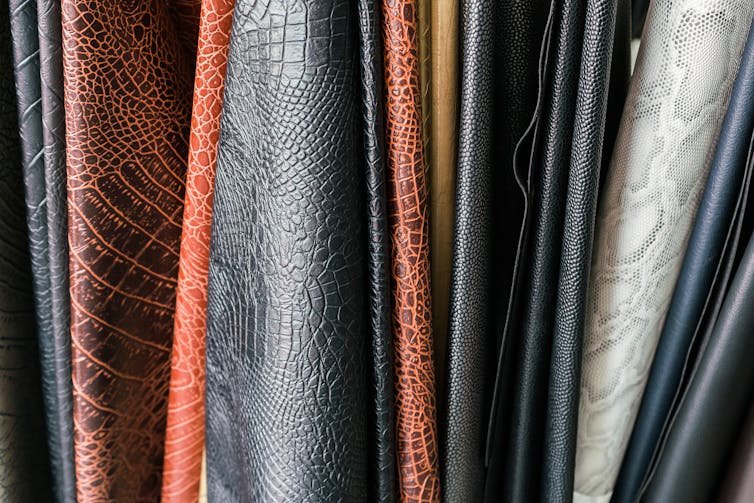Detta inlägg post publicerades ursprungligen på denna sida this site ;
Date:
Author: Songyi Yan, Senior Lecturer in Sustainable Fashion Management, Manchester Metropolitan University
Original article: https://theconversation.com/a-beginners-guide-to-vegan-fashion-and-how-to-spot-greenwashing-253770

“Vegan” and “plant-based” are not just food labels anymore; they are fashion’s latest buzzwords. Imagine walking into a high-street fashion store, drawn to a stylish bomber jacket labelled “100% vegan”. You flip the tag, looking for material details, only to find none. Nearby, a luxury handbag proudly announces it’s made from vegan leather. A closer look reveals it’s 56% recycled polyester and 44% polyurethane – basically plastic.
It’s easy to assume vegan clothes are more ethically and sustainably produced. While it’s evident that vegan leathers avoid animal-derived materials and can support higher animal welfare, labels can be misleading. Many vegan leathers are primarily plastic-based, with environmental consequences that aren’t always communicated clearly.
Even when made from recycled polyester, these materials still contribute to pollution. They will shed plastic microfibres that persist in landfills and oceans for centuries, and require energy intensive recycling. In some cases, plastic-based vegan leather can be more environmentally damaging than natural alternatives such as vegetable-tanned leather, which is a by-product of the meat industry that biodegrades more easily.
Fashion’s veganism doesn’t stop with plastics. Material innovations such as cactus leather, mushroom-based mycelium and algae-derived threads promise exciting alternatives to plastic-based and animal-derived fabrics. Brands often use terms such as “plant-based”, “bio-material”, and “100% biodegradable” to attract consumers. Unfortunately, these labels are often vague, inconsistently defined, and can hide potential issues, including synthetic coatings, unclear biodegradability or short product lifespans.
I’m a researcher in sustainable fashion, focusing on consumer behaviour and sustainability communication. Together with colleagues, I have analysed the websites of 21 innovative materials companies and found that sustainability messaging is often carefully curated and lacking transparency. Vegan alternatives can help brands build an eco image and cut production costs, without necessarily reducing environmental harm.
Few companies disclose important details such as product durability, recyclability or the conditions needed to biodegrade. Meanwhile, terms like “100% biodegradable” can give the impression that their algae-derived T-shirt will simply decompose in the garden – when, in reality, it requires specific industrial conditions such as sustained high heat, controlled humidity and specialised microbial environments to break down properly. Such miscommunication contributes to “greenwashing”, where marketing sounds greener than the reality.

TaraPatta/Shutterstock
To help consumers make informed choices, brand messaging about sustainability needs to be clear and consistent. Terms such as “vegan”, “plastic-free” and “biodegradable” currently lack standardised definitions and aren’t regulated rigorously in markets such as the UK and EU, making them nearly meaningless without verifiable proof. Even upcoming legislation aimed at regulating green claims faces major challenges, as legally binding definitions remain vague.
This lack of transparency isn’t limited to fashion. I’ve seen a vegan sofa marketed without details about its materials, leaving consumers unaware of plastics and synthetic chemicals involved.
Similarly, a computer bag is marketed as made from Banbū, a plant-based material derived from bamboo. While the exact composition isn’t disclosed, similar materials often combine natural fibres with synthetic elements for durability. Without full transparency, it’s difficult for consumers to know whether such items are entirely plastic-free or not.
How to shop smarter
So, what can we do as consumers? With so much greenwashing and fuzzy language, it’s easy to feel powerless. Here are some practical ways to help you question vague eco-claims:
Read beyond the label: Don’t stop at buzzwords such as “vegan” or “plant-based”, check what the product is actually made of. Is it 100% natural or blended with plastics like polyurethane? If material details aren’t listed, that’s a red flag.
Check for trusted certifications: Claims are stronger when backed by certifications. Look out for certifications such as the Global Recycled Standard (GRS), Global Organic Textile Standard (GOTS), or Cradle-to-Cradle Certified™ help verify claims around recycled content, chemical safety and sustainability across products’ lifecycle.
Think long-term: A durable product you can use for years is more sustainable than one that’s vegan but only lasts a season. Ask yourself: Will this item stand the test of time? Can it be repaired, reused, or easily recycled once it reaches the end of its wearable life?
Prioritise transparency: Choose brands that don’t just tell feel-good stories but openly share facts. One good example is Veja – the footwear brand openly discusses its practices with vegetable-tanned leather, admitting it wasn’t durable enough for wide use. While they don’t claim perfection, Veja is relatively honest about their materials, production practices, and sustainability challenges and limitations – that transparency is still quite rare.
Don’t have time to read about climate change as much as you’d like?
Get a weekly roundup in your inbox instead. Every Wednesday, The Conversation’s environment editor writes Imagine, a short email that goes a little deeper into just one climate issue. Join the 45,000+ readers who’ve subscribed so far.
![]()
Songyi Yan does not work for, consult, own shares in or receive funding from any company or organisation that would benefit from this article, and has disclosed no relevant affiliations beyond their academic appointment.